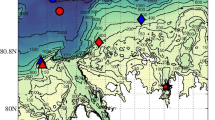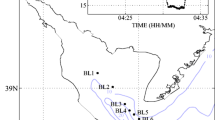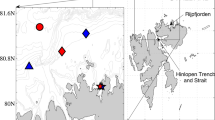Abstract
Bioluminescence (BL) potential observations registered high BL potential emissions during the polar night of January 2012 at the mouth of a fjord Rijpfjorden (northern Svalbard, Norway). Notably, observations of BL potential at this location were significantly higher in the upper 50 m than observed BL potential at offshore stations located on the shelf-slope areas and in the deeper water off northern Svalbard. In the present paper, we address questions as to why the values of BL potential in the fjord are higher than at offshore stations and what the role of advection is in the observed elevation of BL potential values in the fjord in comparison to offshore stations. We utilized the ensemble approach when changes in BL potential are modeled with the advection-diffusion-source (ADS) model, and the focus is on modeling and predictions of a large ensemble of averaged values of BL potential over a specific domain of interest at the fjord mouth. Results of the modeling have demonstrated increases in ensemble members with BL potential values larger than or equal to the specific threshold in comparison to corresponding ensemble members in the initial distribution. Even when we introduced mortality rates in our simulations (values from 0.1 to 0.3 day−1), increases in ensemble members with higher than the threshold value were more than 3.7 times larger in comparison to ensemble members in the initial distribution. The interpretation of our results is that during the polar night, the fjord represents an area where bioluminescent organisms from offshore aggregate through advection and mixing.








Similar content being viewed by others

References
Basedow SL, Sundfjord A, von Appen W-J, Halvorsen E, Kwasniewski S, Reigstad M (2018) Seasonal variation in transport of zooplankton into the arctic basin through the Atlantic gateway, Fram Strait. Front Mar Sci 5:194. https://doi.org/10.3389/fmars.2018.00194
Berge J, Båtnes AS, Johnsen G, Blackwell SM, Moline MA (2012) Bioluminescence in the high Arctic during the polar night. Mar Biol 159:231–237
Berge J, Daase M, Renaud PE, Ambrose WG Jr, Darnis G, Last KS, Leu E, Cohen JH, Johnsen G, Moline MA, Cottier F, Varpe Ø, Shunatova N, Bałazy P, Morata N, Massabuau JC, Falk-Petersen S, Kosobokova K, Hoppe CJM, Węsławski JM, Kukliński P, Legeżyńska J, Nikishina D, Cusa M, Kędra M, Włodarska-Kowalczuk M, Vogedes D, Camus L, Tran D, Michaud E, Gabrielsen TM, Granovitch A, Gonchar A, Krapp R, Callesen TA (2015) Unexpected levels of biological activity during the polar night offers new perspectives on a warming Arctic. Curr Biol 25:2555–2561
Berge J, Daase M, Hobbs L, Falk-Petersen S, Darnis G, Søreide J (2020a) Zooplankton in the polar night. In: Berge J, Johnsen G, Cohen JH (eds) Polar night marine ecology: life and light in the dead of night. Springer Nature, Switzerland AG, pp. 113–160
Berge J, Johnsen G, Cohen JH (eds) (2020b) Polar night marine ecology: life and light in the dead of night. Springer Nature, Switzerland AG
Blachowiach-Samolyk K, Wiktor JM, Hegseth EN, Wold A, Falk-Petersen S, Kubiszyn AM (2015) Winter Tales—the dark side of planktonic life. Polar Biol 38:23–36. https://doi.org/10.1007/s00300-014-1597-4
Bleck R (2002) An oceanic general circulation model framed in hybrid isopycnic-Cartesian coordinates. Ocean Model 4:55–88. https://doi.org/10.1016/S1463-5003(01)00012-9
Campbell JW (1995) The lognormal distribution as a model for biooptical variability in the sea. J Geophys Res 100:13,237–13,254
Cohen JH, Berge J, Moline MA, SørensenAJ LK, Falk-Petersen S et al (2015) Is ambient light during the high Arctic polar night sufficient to act as a visual cue for zooplankton? PLoS One 10(6):e0126247. https://doi.org/10.1371/journal.pone.0126247
Cohen JH, Berge J, Moline MA, Johnsen G, Zolich AP (2020) Light in the Polar Night. In: Berge J, Johnsen G., Cohen JH (Eds.) Polar night marine ecology: life and light in the dead of night. Springer Nature, Switzerland AG, pp. 37–66
Cronin HA, Cohen JH, Berge J, Johnsen G, Moline MA (2016) Bioluminescence as an ecological factor during high Arctic polar night. Sci Rep 6:36374. https://doi.org/10.1038/srep36374
Cummings J, Bertino L, Brasseur P, Fukumori I, Kamachi M, Martin MJ, Mogensen K, Oke P, Testud CE, Verron J, Weaver A (2009) Ocean data assimilation systems for GODAE. Oceanography 22(3):96–109
Daewel U, Schrum C (2013) Simulating long-term dynamics of the coupled North Sea and Baltic Sea ecosystem with ECOSMO II: model description and validation. J Mar Syst 119–120:30–49
Falk-Petersen S, Pavlov V, Berge J, Cottier F, Kovacs KM, Lydersen C (2015) At the rainbow’s end: high productivity fueled by winter upwelling along an Arctic shelf. Polar Biol 38:5–11. https://doi.org/10.1007/s00300-014-1482-1
Friedrichs MAM, Dusenberry J, Anderson L, Armstrong R, Chai F, Christian J, Doney SC, Dunne J, Fujii M, Hood R, McGillicuddy D, Moore K, Schartau M, Sptiz YH, Wiggert J (2007) Assessment of skill and portability in regional marine biogeochemical models: role of multiple phytoplankton groups. J Geophys Res 112(CO8001). https://doi.org/10.1029/2006JC003852
Herren CM, Haddock SHD, Johnson C, Orrico CM, Moline MA, Case JF (2005) A multi-platform bathyphotometer for fine-scale, coastal bioluminescence research. Limnol Oceanogr Methods 3:247–262
Hogan TF, Liu M, Ridout JA, Peng MS, Whitcomb TR, Ruston BC, Reynolds CA, Eckermann SD, Moskaitis JR, Baker NL, McCormack JP, Viner KC, McLay JG, Flatau MK, Xu L, Chen C, Chang SW (2014) The navy global environmental model. Oceanography 27(3):116–125. https://doi.org/10.5670/oceanog.2014.66
Johnsen G, Candeloro M, Berge J, Moline M (2014) Glowing in the dark: discriminating patterns of bioluminescence from different taxa during the Arctic polar night. Polar Biol 37(5):707–713. https://doi.org/10.1007/s00300-014-1471-4
Messié M, Shulman I, Martini S, Haddock S (2019) Using fluorescence and bioluminescence sensors to characterize auto- and heterotrophic plankton communities. Prog Oceanogr 171:76–92. https://doi.org/10.1016/j.pocean.2018.12.010
Metzger EJ, Smedstad OM, Thoppil PG, Hurlburt HE, Cummings JA, Wallcraft AJ, Zamudio L, Franklin DS, Posey PG, Phelps MW, Hogan PJ, Bub FL, DeHaan CJ (2014) US navy operational global ocean and Arctic ice prediction systems. Oceanography 27(3):32–43. https://doi.org/10.5670/oceanog.2014.66
Moline MA, Blackwell SM, Allen B, Austin T, Forrester N, Goldsborogh R, Purcell M, Stokey R, von Alt C (2005) Remote environmental monitoring units: an autonomous vehicle for characterizing coastal environments. J Atmos Ocean Technol 22:1798–1809
Shulman I, Anderson S (2019) Bioluminescence potential modeling with an ensemble approach. Ocean Dyn 69:599–614. https://doi.org/10.1007/s10236-019-01264-4
Shulman I, Moline MA, Penta B, Anderson S, Oliver M, Haddock SHD (2011) Observed and modeled bio-optical, bioluminescent, and physical properties during a coastal upwelling event in Monterey Bay, California. J Geophys Res 116(C01018). https://doi.org/10.1029/2010JC006525
Song H, Edwards CA, Moore AM, Fiechter J (2012) Four-dimensional variational data assimilation of positive-definite oceanic variables using a logarithm trans- formation. Ocean Model 54–55:1–17
Vernet M, Ellingsen IH, Seuthe L, Slagstad D, Cape MR, Matrai PA (2019) Influence of phytoplankton advection on the productivity along the Atlantic water inflow to the Arctic Ocean. Front Mar Sci 6:583. https://doi.org/10.3389/fmars.2019.00583
Wassmann P, Slagstad D, Ellingsen I (2019) Advection of Mesozooplankton into the northern Svalbard shelf region. Front Mar Sci 6:458. https://doi.org/10.3389/fmars.2019.00458
Funding
This research was funded through the US Naval Research Laboratory under program element 61153N. Computer time for the numerical simulations was provided through a grant from the Department of Defense High Performance Computing Initiative. This manuscript is US NRL contribution 7330-19-4792.
Author information
Authors and Affiliations
Corresponding author
Additional information
Responsible Editor: Alejandro Orfila
Appendix
Appendix
Consider the following variable λsatisfying the adjoint to (1) equation:
with initial conditions at t = T:
and boundary conditions:
Boundary Sd includes all boundaries of D: lateral boundaries, surface, and bottom.
We multiply (1) by λ and subtract (15) multiplied by C and integrate over domain D and time [t0, T]:
Using (17) and non-divergent condition for velocity, the first term on the right site of (18) is equal to zero:
Because
and boundary conditions (17), the second term on the right site of (18) is also equal to zero:
For left site of (18) we have:
Combining (19)–(22) together, we have:
In accord to (23) and (16), we have:
Rights and permissions
About this article
Cite this article
Shulman, I., Moline, M.A., Cohen, J.H. et al. Bioluminescence potential modeling during polar night in the Arctic: impact of advection versus local sources. Ocean Dynamics 70, 1211–1223 (2020). https://doi.org/10.1007/s10236-020-01392-2
Received:
Accepted:
Published:
Issue Date:
DOI: https://doi.org/10.1007/s10236-020-01392-2



